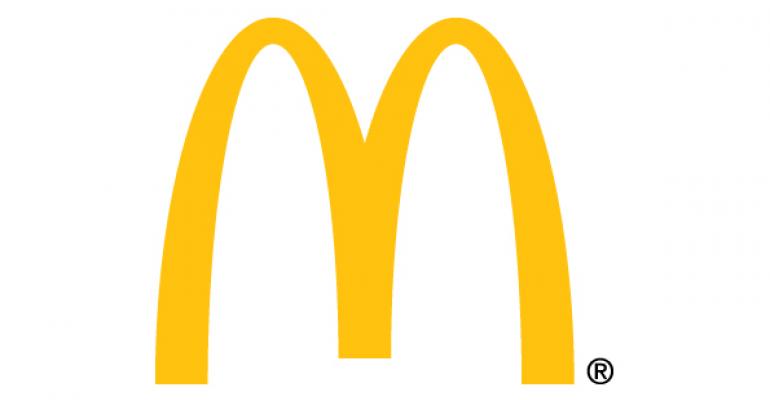McDonald’s Corp. reported on Friday that its global same-store sales fell 0.9 percent in the fourth quarter, including a 1.7-percent decline in U.S. same-store sales, amid what the company called “ongoing, broad-based challenges, including sustained competitive activity.”
McDonald’s also suggested that pressure would continue in the first half of 2015. CEO Don Thompson said global same-store sales in January would be negative.
“2014 was a difficult year, during which our performance fell short of our expectations,” Thompson said during the company’s earnings call Friday. “We’re well aware of the obstacles we face in terms of growing comparable sales and margins amid broad-based challenges.”
McDonald’s fourth-quarter net income fell 21 percent, to $1.1 billion, from $1.4 billion the previous year. Revenue declined 7 percent during the quarter, to $6.6 billion, from $7.1 billion. For fiscal 2014, McDonald’s net income fell 15 percent, to $4.8 billion, from $5.6 billion the previous year. Overall company revenue fell 2 percent during the year, to $27.4 million, from $28.1 million.
On the bright side, McDonald’s same-store sales rose 0.4 percent in the U.S. in December, the only month during the year in which same-store sales rose.
But that wasn’t enough to offset what executives acknowledged was a challenging year.
Executives said on Friday that the company is reducing capital spending and building fewer locations in the quick-service chain’s weakest markets — including the United States.
Pete Bensen, McDonald’s chief financial officer, said the company would spend $2 billion on capital expenditures for the year, about $1 billion less than planned and the lowest amount in more than five years. He said the company expects to open 1,000 restaurants in China, Russia, the United States and France in 2015 — 300 fewer than the number opened in those markets in 2014.
“We believe this lower level of capital spending is prudent while we work to regain our business momentum and improve the sales and profitability at our more than 36,000 restaurants around the world,” Bensen said in a statement Friday.
McDonald’s biggest troubles were at home, where guest counts fell 4.1 percent for the year, resulting in a same-store sales decline of 2.1 percent for the year.
The drop resulted in a 1.1-percent decline in U.S. systemwide sales, according to SEC filings — the chain’s first decline in domestic systemwide sales in at least 30 years. Systemwide sales fell by more than $400 million, to $35.5 billion, from $35.9 billion in 2013. Executives cited a competitive market and a restaurant industry that is growing slowly overall.
“It’s a market share game,” said McDonald’s USA president Mike Andres. “It’s always going to be a market share game.”
Company executives further outlined turnaround plans, key to which is menu simplification. McDonald’s is reducing the number of Quarter Pounder, Premium Chicken sandwiches and Snack Wraps to one option apiece, and is cutting the number of Extra Value Meals it offers. Those efforts have been tested in certain markets, and the simplification effort is being expanded companywide this week, Andres said.
Executives said the “menu rationalization” effort has lifted sales in those markets because the less complex menu has sped throughput.
Andres also left open the possibility that more items could be cut from the menu in the future, noting that the “rationalization process is ongoing.” However, he was quick to note that “no single initiative is going to drive improvement.”
Pockets of success and turnaround efforts
(Continued from page 1)
Executives also discussed the chain’s menu customization platform, Create Your Taste. The platform will enable dine-in guests to customize burgers or chicken sandwiches by ordering on their phones or from kiosks. Food is served at the table.
“This is not just about food,” Thompson said. “It’s about digital engagement with customers through kiosks and mobile ordering. It’s about physical changes; how we present the food so you can understand the freshness of produce. It’s about the overall experience.”
McDonald’s said operating income in the U.S. fell 15 percent in 2014 due in part to expenses related to its turnaround effort. Executives also said they have identified $100 million in general and administrative savings that will be redirected to priority areas — notably digital efforts.
McDonald’s was hit by other issues during the year, too, including a food safety scare in Asia that weighed down sales in its Asia, Pacific, Middle East and Africa (APMEA) region. Same-store sales for the region fell 4.8 percent in the fourth quarter, the company said.
Same-store sales fell 1.1 percent in Europe, which has been beset by weakness in Germany and political problems in Russia.
McDonald’s stock fell more than 1 percent in trading Friday morning, and analysts called the company’s results “mixed.” Stifel analyst Paul Westra said the release was “better-than-feared” for some and “worse” for others.
Westra said the company’s turnaround will require patience “as management works on a largely U.S.-led brand reinvention project to tackle global demand trends toward lifestyles of health and sustainability for Millennials and for aging Baby Boomers and overcome up-and-coming fine-casual competitors.”
Thompson also preached patience. “2015 will be a year of regaining momentum globally,” he said. “There have been pockets of success. But it will take time, especially in larger markets.”
This article has been revised to reflect the following correction:
Correction: Jan. 23, 2015 An earlier version of this story misstated McDonald’s U.S. systemwide sales. Systemwide sales decreased to $35.5 billion in 2014, from $35.9 billion the previous year.
Contact Jonathan Maze at [email protected].
Follow him on Twitter: @jonathanmaze

